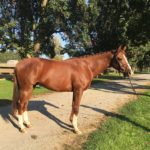We’ve now seen a total of seven lions and can’t get over how beautiful they are. ?Even when they are thinking about eating you.
Our first encounter with ngala (Shagaan for nature’s biggest cat) was in Karongwe, the nature preserve Wait a Little shares. ?In that preserve they have just one pride of lions so they have to do a little artificial population control – removing some cats and bringing in different genetic pools. ?At this time they are in process to introduce two new lionesses to the reserve. ?The two are penned in a two-hectare (about four acres) electric fenced space within the reserve. ?Within 48 hours of their arrival, the resident lions were at the fence. ?So, for a short period of time, it has become shockingly easy to find the lions in Karongwe.
We set out on the horses at 7:00 AM with Philip Kusseler – the owner of Wait a Little – as our guide. ?Within an hour we had arrived at the area of the pen and had a distant view of the lionesses in their enclosure.

Phillip left us gathered in a tight group – the horses were on high alert – and did some reconnaissance. ?He was back within moments and led us a short distance down a nearby road in sight of a male lion reclining where he could see into the pen.

This male lion (they call him ‘Zero’) did not even acknowledge our existence. ?Phillip coached us in hushed tones – as we clustered our horses in a tight group behind him – what to do if the lion got up and started walking toward us. ?Instead, like a true cat, he flopped over flat, stretching out one enormous paw.
We quietly retraced our steps back up the road to our original position near the pen. ?The lionesses, who we’d only seen from afar earlier, were now in full view. ?Unlike the male, who is very used to the horses, they were highly interested in us and had been tracking every move of this tasty-if-weird-looking herd of creatures. ?They had moved close to the fence and were dropped into hunting position, one so low in the grass that only her eyes and ears were showing.
They were so very beautiful. ?It didn’t hurt that I knew they couldn’t get me or Eric (my Arab cross scaredy cat of a horse). ?Seeing them in their natural element, doing what they are supposed to do, was simply amazing.
But, of course, they need to understand the Karongwe rules about not eating horses. ?So Philip told us all to drop back a bit and take hold of our horses. ?He then unfurled his bull whip (one of three guide tools he carries, along with a fire-cracker type device and a high-caliber pistol), whirled it around his head and cracked it at the cats.
The horses all started violently and the cats bolted some distance from the fence. ?He cracked it a second time and one of them emitted a bark of surprise and they took off, out of sight.
I figured that that was my lifetime encounter with ngala, but the following day we were treated to a vehicle-based game drive in a neighboring preserve called Makalali. ?As soon as we set out our guides told us that ngala had been seen at a watering hole and we were going to hot-foot it across the preserve to see if we would catch them.
Again, we are certainly dealing with cats here. ?Big extremely dangerous cats, but cats all the same. ?We needn’t have hurried. We found a lioness and her three adolescent cubs lounging indolently for the entertainment of three full safari trucks. ?They’d been there a while, it seemed.

The two female cubs wrestled on the shore, showing us plenty of lion belly while their brother -sporting the lion equivalent of a patchy teenage beard – reclined as regally as possible some distance away. ?Until finally he, too, flopped over flat like the useless cat he clearly was.
Epilogue
This morning’s ride in Makalali was singularly uneventful. ?We made up for it in spades this afternoon.
The horses had been on high alert several times during our ride, so we were being careful as we tracked elephant. ?We stumbled across a large pod of hippos early in the ride, so we were pretty happy with the progress. ?We’d ridden down one side of the river, crossed and were heading back up the other when a monkey started alerting up in a tree. ?Both monkey and bird calls are used by guides to help locate animals and evaluate whether danger lies ahead.
Our guide, Rusty, had us hold under the tree as he tried to see what the monkey was yelling about. ?He then decided, instead of continuing beside the river, to head inland on a different trail and as we moved out a young male lion rushed out from some heavy bush, right where the monkey had been looking.
Rusty yelled at the lion and spun his horse to face it. ?Meanwhile the majority of the other horses shied badly, effectively retreating about 40 feet. ?It was impressive that we were able to keep them in the area at all. ?They are still prey animals and flight is an instinct when faced with a charging predator.
Several of the braver horses didn’t move at all. ?I had been riding in the rear and as the horses folded back on us, Eric fell back a few feet as well. ?We all got our horses righted, facing the danger, while the riders on those braver horses yelled to Rusty where the lion had retreated to.
Rusty had lost his bull whip in the first melee, so he fired a firecracker in the cat’s direction, forcing it to retreat father. ?The horses were bunched forward again at this point and we – as calmly as possible – swapped ends and walked back the way we’d come. ? As Rusty followed us out, he thanked the monkey for his service.
So call it eight ngala and a new affection for monkeys.







